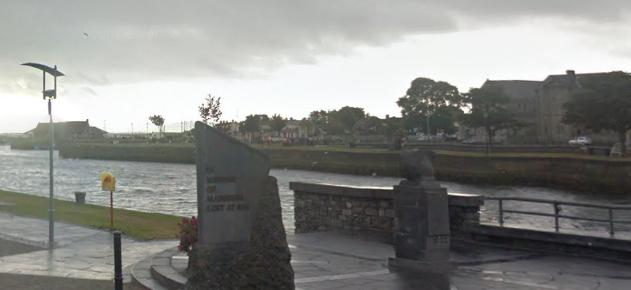From Galway to the End of the Earth and Beyond
In 1477, Galway had a visitor, lauded a navigational hero to some, a tyrant to more due to his treatment of the natives who encountered him in America some years later, its thought that he was on a voyage to either Iceland or the Faroe Islands at the time he landed in Galway, though many who recount the tale think it was as part of his voyage when he found the New World.

He and his crew were some of the many Spanish who sailed into Galway port selling spirits and goods, and buying more for bringing back home. Galway was a major stop off point for sailors heading north and south down the Atlantic seaways.
Of interest is his notation in his copy of a book (1) (according to his son in his book “The Life of the Admiral Christopher Columbus by his Son Ferdinand”) Imago Mundi he recorded : “Men of Cathay have come from the west. [Of this] we have seen many signs. And especially in Galway in Ireland, a man and a woman, of extraordinary appearance, have come to land on two tree trunks [or timbers?] or a boat made of such?”
So, who were these “men of Cathay?” – of note is they “came from the west” – could they have sailed from the New World and discovered Galway before Columbus sailed west and discovered America?
We have to remember Europeans were ignorant of America, and actively believed in Hy Brasil and other mythical landmasses, so folk of Chinese appearance – as many Native Americans look to to the then ignorant European eye – would have been thought of as been from Cathay. Or they could have been Inuit as some people think.
Another version has the story that is was bodies on the boat, not live sailors. Which is the truth we will likely never know.
Some decades later, this Genoan in Galway was to sail West, and leave a mark that would be felt to the present day and beyond.
In typical TomTom fashion, when he DID arrive in the Caribbean, he confidently declared he was after reaching India, which is why the natives have been known as Indians ever since.
Only to find he was somewhere else entirely!
There are times thinking of this fiasco I wonder was he actually Irish! And if he was, he must have been from Longford!
Legends of an Irishman left on the islands as part of the settlement are contested as unfounded. If this strange Guillermo Ires / Guillermo Herries did settle there, he was the first Irishman in the Caribbean! Indeed a group wanting to name a bridge after him the Guillermo Herries League were in contact with NUIG, but they failed in their attempt both to verify the story and name the bridge.
So who was Guillermo Ires (there are many spellings of the name, as its an Italian writing probably phonetically a name given to him in Spanish)? Some think he was Eyre, due to the connections of that family with Galway. More that he was Erris or even Harris.
It probably was William the Irishman, as Ires is very similar to Erse, an old English term for Irishman, now only used on the Scots dialects, and there normally to put someone down. But originally, it just meant Irishman, and would be used with the standard word “Irish” as we use Scots and Scotch for a person from Scotland.
Either way, its interesting walking past the Columbus monument in Galway, whene people believed there was “Non Plus Ultra”.
We found there was, so much so the motto of Spain is now “Plus Ultra”
We on planet earth could have “Non Plus Ultra” as the motto of the planet. Will there be a time when we do find there is an intergalactic “Plus Ultra”?… and will those who find it have a connection in Galway?
Only time will tell!
Reference:
[1] Its unsure who wrote “Immago Mundi”, as even the original manuscript of Ferdinands book does not survive. The assume it was the book by Imago mundi et tractatus alii. Louvain: Johann de Paderborn, of 1483 but if it was that would date Columbus visit to Galway to after 1483 not 1477 as tradition records it.
There was probably more than one book of the same name. Indeed the accuracy of information and dating of events in Ferdinands book is questioned, with more than one “more accurate” translation done since its publication.
If more accurate information comes to light it will be posted, if you can post any please message us or post below!